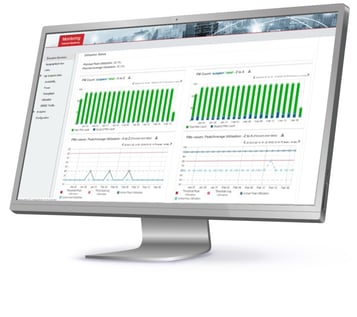With global energy costs continuing to rise and government carbon emissions (CO2) restrictions tightening, network operators of every kind are left looking for innovative solutions to ever-increasing sustainability challenges.
In a recent blog post focused on sustainability for wireless transport networks, we covered a variety of solutions tailored to the needs of Private Network Operators (PNOs), Internet Service Providers (ISPs), and Communications Service Providers (CSPs). All the options presented focused on balancing the need to cut energy costs, meet regulatory obligations, and improve network performance.
One of the most impactful tools we covered was the integration of Artificial Intelligence (AI) in network monitoring and management. Ceragon Insight, the AI-assisted network monitoring and management solution, enables significant energy reduction while ensuring optimized network performance.
In this blog post, we'll explore the sustainability challenges Ceragon Insight addresses, how AI assists in network energy reduction, and the business benefits Ceragon Insight delivers.
The Need for Energy-Efficient Wireless Transport Solutions:
Whether your priority is cutting energy costs, complying with carbon emission restrictions, or improving network performance, you know that every watt consumed matters. Out of control, unpredictable OPEX is only the start.
Here is our short list of sustainability and energy-related challenges faced by network operators.
- Energy Costs and Operational Efficiency
Curbing power consumption directly impacts energy bills and operational costs. Lower costs translate into improved financial performance and the positive potential for future investments and growth. - Regulatory Compliance
Energy conservation through power-saving measures aids in reducing carbon footprints, promoting green initiatives, and adhering to regulatory requirements and environmental standards. - Network Availability and Resilience
In the event your network’s primary power source experiences downtime, your secondary power source should automatically step in to cover the demand. Most emergency power sources have limited capacity. Minimizing your network’s total power draw ensures network continuity during power outages, bolstering network resilience. - Scalability and Future Growth
Optimizing power usage allows operators to maximize the potential of their existing infrastructure. In many instances, an energy-efficient network can accommodate additional
network elements enabling you to meet growing data and connectivity demands without draining resources. - Remote and Off-grid Deployments
In challenging environments where conventional power sources are scarce, energy-efficient solutions reduce reliance on external power sources, cut maintenance costs, and facilitate cost-effective network deployments. - Sustainability and Environmental Responsibility
The telecommunications industry plays a significant role in global energy consumption and carbon emissions. Prioritizing power-saving practices is crucial for sustainability and addressing climate change.
How AI Impacts Transport Network Energy Efficiency
Ceragon Insight combines powerful cross-vendor network device management with AI analytics to achieve new levels of power savings and performance. Let's delve into some examples and data from Ceragon’s recent White Paper to illustrate how it works.

Figure 1 - Ceragon Insight utilization analytics
- Conserving Power During Non-Peak Periods
Imagine an ISP servicing a bustling city during the day. The demand for connectivity is at its peak, with businesses, schools, and households all online simultaneously. During these hours, Ceragon Insight ensures that every radio is active, providing the highest level of service.
However, in the early hours of the morning, while most of the city sleeps, the demand drops significantly. Instead of keeping all radios active and at peak energy consumption, Ceragon's AI steps in. It identifies underutilized radios and temporarily powers them down. This doesn't affect the network's overall performance but results in substantial energy savings and a subsequent reduction in CO2 emissions.
As the city wakes and demand surges again, Ceragon Insight preemptively increases capacity bringing the necessary radios back into action.

Figure 2- 7-day usage cycles Illustrating when utilization of the link is below 50%.
- The Impact of Power-Saving
Ceragon's solution focuses on reducing power consumption in Radio Carrier systems, specifically in RF Power Amplifiers (PAs). RF PAs amplify radio frequency signals and consume a significant portion of power in wireless communication systems.
The "Mute" operation involves temporarily shutting down RF transmission during periods of inactivity, leading to energy savings and improved efficiency. Importantly, it does not affect the Mean Time Between Failures (MTBF) of hardware components.
- It's All About Analytics and Automation
Implementing power-saving measures on a large scale, especially in networks with hundreds of links, requires automation and deep analytics. Ceragon Insight offers complete visibility and control for wireless transport networks, combining power-saving analytics with automation.
- Power Saving Analytics
This feature identifies time windows when peak link utilization falls below a predefined threshold, allowing power conservation without affecting network performance. It mutes carriers during these periods, effectively reducing power consumption.
- Power Saving Automation
Automation triggers are customizable and can be based on factors like network capacity, utilization peak, and time-based conditions. For example, actions can be scheduled to occur during off-peak hours or low-traffic periods. This dynamic approach empowers network operators to optimize energy efficiency while maintaining reliable services.
The Benefits of the Solution:
The implementation of Ceragon Insight’s AI-assisted network monitoring and management offers a range of benefits for Private Network Operators (PNOs), Internet Service Providers (ISPs), and Communications Service Providers (CSPs).
- Significant Energy Savings
Automating the shutdown of underutilized radios during off-peak hours leads to substantial energy cost savings. The dynamic approach fine-tunes power consumption based on real-time usage patterns, conserving power without compromising network reliability.
- Cost Reduction and Sustainability
The financial benefits of energy-efficient practices lead to reduced energy costs and improved network profitability and sustainability. By automating power-saving measures, operators can calculate cost reductions that directly contribute to a smaller carbon footprint and greater environmental responsibility.
- Maximizing Network Efficiency
Ceragon Insight empowers network operators to balance energy consumption with government regulations while maintaining peak network performance. It offers complete visibility into network utilization and predictive analytics to identify opportunities for power savings.
A Win-Win for Wireless Transport Networks
Energy costs will likely continue to rise, and environmental concerns continue to grow. Ceragon Insight’s AI-assisted network monitoring and management serves as a valuable tool for wireless transport network operators looking to tackle these challenges head-on. By optimizing power usage and implementing automation and analytics, network operators can achieve substantial energy savings without compromising network reliability, ultimately contributing to cost efficiency, regulatory compliance, and sustainability. It's a win-win for operators, the environment, and the future of wireless connectivity.
Interested in learning more about how Ceragon Insight can help lower your network’s energy consumption?


